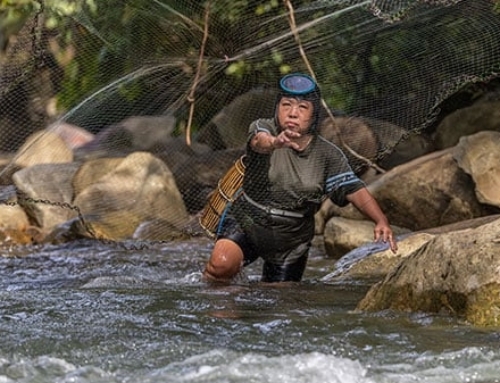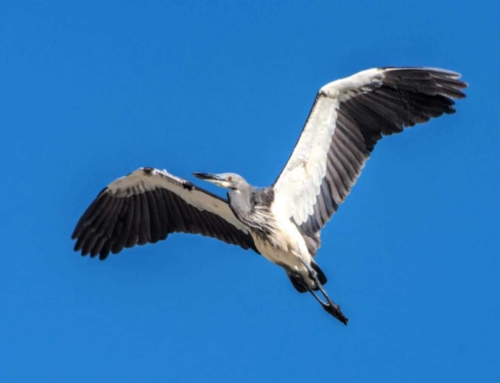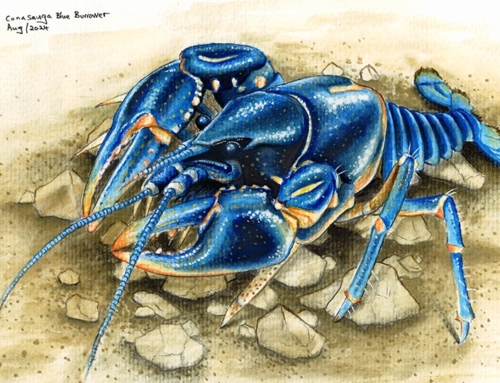What role do rivers play in your life? For billions of people around the world, they are – literally – their source of life and survival. Although rivers cover less than one percent of the Earth’s surface, they are the most biodiverse and productive ecosystems in the world. In this post, Félix Feider looks at the much overlooked role that rivers and freshwater ecosystems can play in combatting the impacts of climate change and invites us to rethink the importance of freshwater biodiversity conservation as a tool to help us with that struggle.
Imagine your survival was dependent on a healthy free-flowing river – how would you feel if that river dried up? This is the reality that millions of people are already facing: mighty rivers, such as the Colorado, the Indus, the Murray, or the Yellow River, now frequently run dry before reaching the sea. In the UK, the source of the River Thames recently dried up for the first time in living memory, and major rivers all over Europe are currently drying up in the climate-driven drought.
The world’s rivers are suffering. Not only are they facing more intense climate-crisis induced droughts, but they are also being destroyed, dammed, overexploited, and polluted. The scale of this destruction has led to freshwater species disappearing at a much faster rate than terrestrial or marine species. Despite this, freshwater ecosystems are routinely ignored: too often, those responsible for prioritising conservation action, allocating environmental funding or developing infrastructure overlook the life-sustaining and vital role of healthy freshwater habitats.
This lack of attention for our rivers has wider implications: by failing to prioritise freshwater conservation, we are also ignoring a critical ally in the fight to reduce the impacts of the climate crisis.
Locking away carbon
When we talk about ‘nature-based solutions’ to the climate crisis, we often tend to focus on trees and forests. One great and powerful ally that we often forget about and undervalue is Earth’s rivers.
As rivers meander through valleys, plains, and forests, they pick up organic matter, such as decomposed plants and soil, which they transport from source to sea. On reaching the ocean, this organic matter sinks to the ocean floor where it is locked away until it surfaces several million years later in the form of rocks. This phenomenon forms ‘river plumes’ that can extend tens of kilometres into the ocean. Examples include the Amazon River plume and the Congo River plume, both of which are recognised to form carbon sinks of global importance.
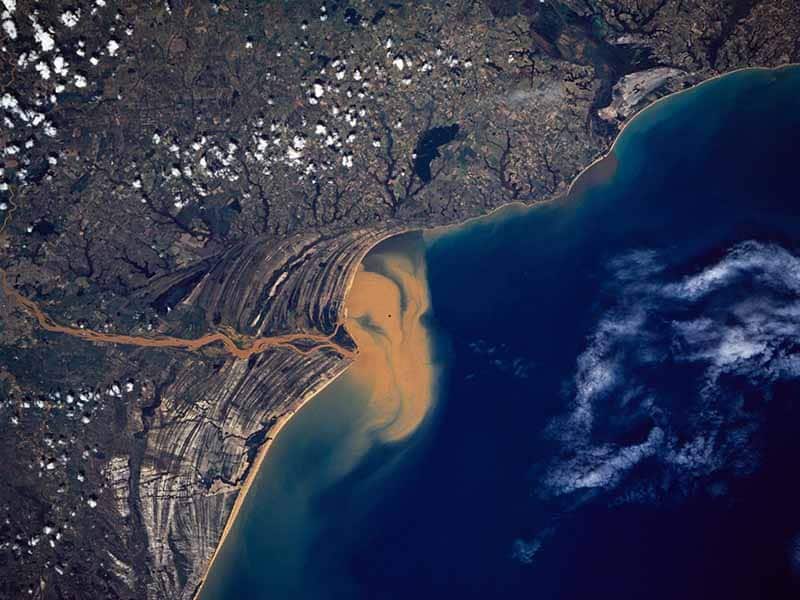
An aerial photo of a river plume in Paraiba do Sul river delta in Brazil. Image: NASA
In 2015, researchers estimated for the very first time that globally rivers transport 200 million tonnes of carbon to the ocean every year. While this only represents 0.2 per cent of atmospheric carbon, over 1,000 years, that adds up to 20 per cent of total atmospheric carbon. Rivers alone will not be able to lock away enough carbon in time to reverse the climate crisis, but they play a vital part in the global carbon cycle and are powerful allies in mitigating the impacts of the climate crisis. Additionally, rivers feed and sustain wetland ecosystems, such as peatlands, and these are known to store twice as much carbon as all the world’s forests combined.
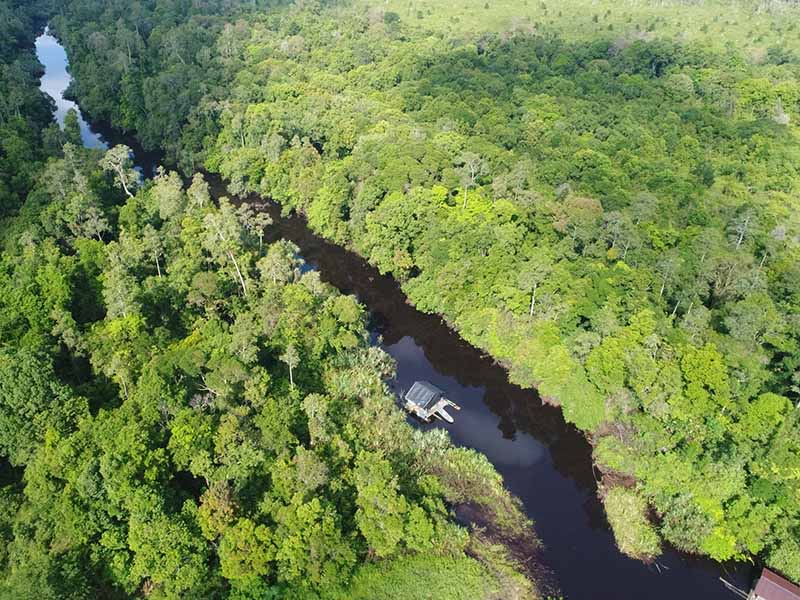
Southeast Pahang peat swamp, Pahang, Malaysia. Image: Global Environment Centre
Adapting to the age of the climate crisis
The science is clear that the world is rapidly warming, a phenomenon that is already leading to disastrous impacts around the world. Heatwaves, flooding, droughts, wildfires, rising sea levels – these impacts are most intensely witnessed by the global majority in tropical and sub-tropical countries. These countries and communities tend to have fewer means to adapt to these challenging circumstances and yet they have contributed least to the causes of these extreme events.
One cost effective and impactful way of increasing the capacity of communities to adapt to the ongoing climate crisis, is to invest in protecting and restoring rivers and riverbanks.
While it might be counterintuitive to rely on rivers and their flood pulses to adapt to floods, research shows us that floods are most destructive where rivers have been “tamed” by grey infrastructure (canals, dams, walls, or levees).
The natural wetlands that are fed by rivers protect communities from flooding, but also store water during drier times, so can turn into natural water stores during droughts.
Increasing wildfires are also associated with climate induced droughts. Rivers act as natural barriers to wildfires, and feed wetlands that are naturally more resistant to fires. Areas where rivers and wetlands are destroyed, tend to be more susceptible to wildfires.
Another growing risk is the drowning of river deltas that are rich in biodiversity, extremely productive, and home to over 500 million people. Rivers transport sediment over hundreds of thousands of kilometres, from deep inland to these deltas, sustaining them and helping them to grow and keep up with rising sea levels.
Rivers alone support one third of global food production, provide billions with clean water and offer a source of income to millions. In volatile and uncertain times, it becomes increasingly important to protect the basic services that rivers provide to those most impacted.
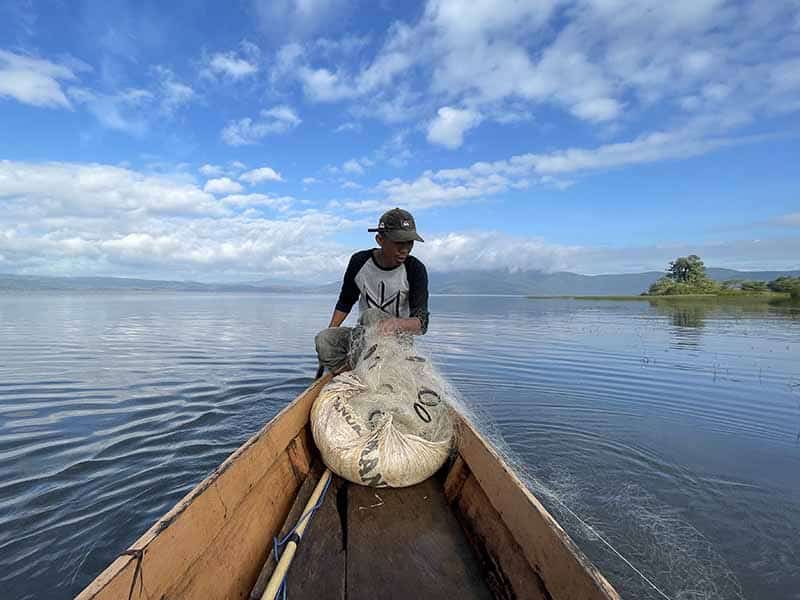
Selective fishing can help to avoid the capture of non-target species. Image: Yayasan Bumi Sawerigading
By valuing and protecting rivers and their associated ecosystems, we protect the integrity of life on Earth and contribute to a climate-resilient future.
Taming rivers – hurting biodiversity, climate, and people
Over the past decades however, rivers have been heavily damaged. Most rivers have been dammed and no longer flow uninterrupted from source to sea, a situation which has contributed significantly to the rapid 84 per cent decline in the populations of freshwater species experienced since 1970. Dams and other grey infrastructure such as canals are not only disastrous for freshwater species and ecosystems, but also reduce a river’s ability to lock away carbon and reduce the negative impacts of extreme weather events.
Ironically, hydropower dams in the tropics, which are widely considered as a reliable form of renewable and green energy, are also known to be huge carbon emitters.
Carbon emissions from dams around the world are estimated to add up to as much as Canada’s annual carbon emissions. It is estimated that one in ten hydropower dams emit as much greenhouse gases per unit of energy as coal-fired power plants.
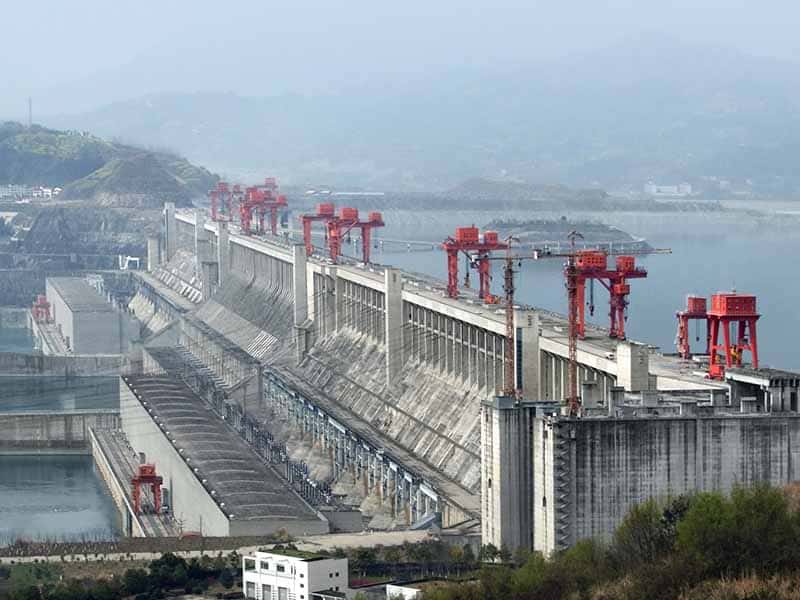
The Three Gorges Dam on the Yangtze River in China. Image: iStock
Dams also trap river sediment, and thereby reduce a river’s ability to lock away carbon in the ocean and to sustain and grow deltas. As a result, the world’s deltas are sinking around four times faster than can be explained by sea level rise alone. More than half of the Mekong River delta, home to 21 million people, could be underwater by the end of the century due to a lack of sediment supply from heavily dammed rivers and sea level rise.
By taming, drowning, or drying up rivers, we destroy natural flood and drought protections, and risk the collapse of carbon-rich ecosystems as well as complex socio-environmental systems on which people have depended for millennia.
Beyond this, the destruction of rivers also risks destroying the deep and meaningful emotional, cultural, and spiritual connections between people and rivers that have existed and evolved over millennia. Many communities, especially Indigenous Peoples, attribute spiritual and sacred values to rivers. For instance, the Ngarrindjeri of Australia see the River Murray as “an immense artery of a living body consisting of the Lakes and the bush and over the southern plains and undulating plain”. In Hinduism, the River Ganges, embodied by the goddess Ganga, Mother of all human beings, is considered the holiest of rivers. New Zealand’s Whanganui River, long revered by Māori who see it as a living breathing ancestor, even became the first river in the world recognised as having the same legal rights as a person in 2017.
As water is nowadays mainly seen as a resource to exploit for economic development, the perspectives of Indigenous Peoples and local communities are cast aside to pursue mining, oil extraction, and the development of large dams for hydroelectricity. One such example is the damming of Celilo Falls (or Wyam, meaning “echo of falling water”), a historically important tribal fishing area on the Colorado River for over 15,000 years. Native settlements nearby and the falls were completely destroyed and submerged by the Dalles Dam in the 1950’s. A more recent example can be seen in the Ecuadorian Amazon. In 2020, three oil pipelines ruptured and contaminated the Coca River with over 15,000 barrels of oil, with dire consequences for 27,000 members of downstream Indigenous communities.
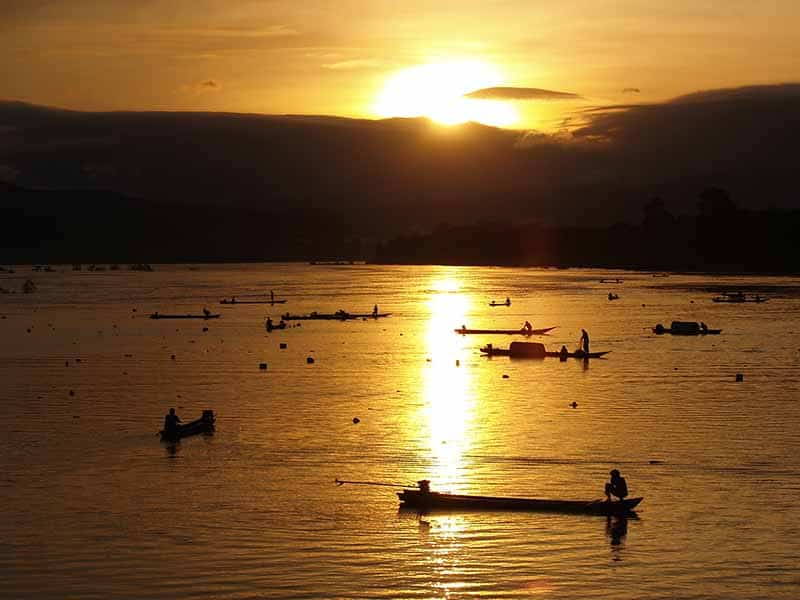
Fisherman in boats in sunset. Image: Living River Association
Resilient rivers – resilient future
Rivers are too often overlooked when discussing the climate crisis, and their health and that of riverine communities is too often sacrificed when short-sighted development projects are implemented.
The climate crisis cannot be addressed without addressing the freshwater biodiversity crisis, and vice versa, and we desperately need solutions that address both holistically: solutions that promote river connectivity and health and unlock their potential to lock away carbon and help communities globally to adapt to a rapidly changing climate.


